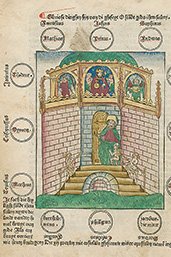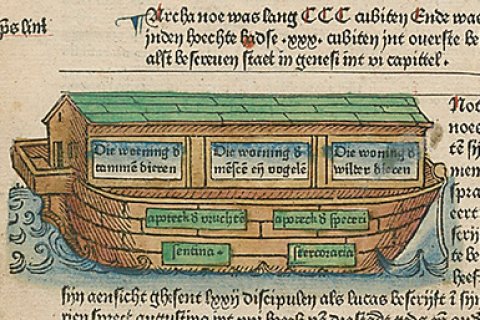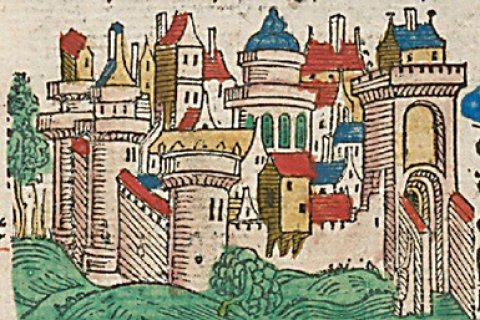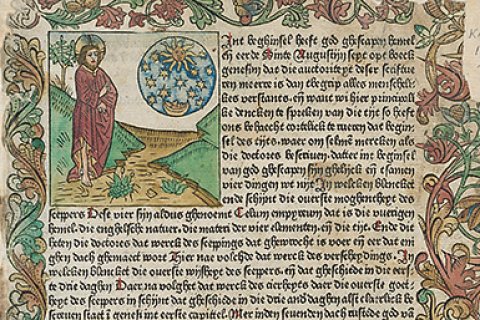'Fasciculus temporum' by Werner Rolevinck
A chronicle in colour

As a rule, incunables are not known for their exuberant look and content. However, the chronicle Fasciculus temporum is a positive exception to this general rule. It is a masterpiece, both in terms of typography and illustrative art. What’s more: the edition presented here was published in Utrecht in 1480.
Written by a Carthusian monk
The text of the Fasciculus temporum was written by Werner Rolevinck (1425-1502). He was a Carthusian monk, publishing in the field of ecclesiastical history and exegetical art. In the Carthusian monastery of St. Barbara in Cologne he produced over fifty writings, including sermons, historical works and Bible exegeses. The Fasciculus temporum from the 1470s belongs to his major works. In the book Rolevinck presents the general world history in an orderly manner.
Beautiful illustrations

It goes without saying that religious views and opinions played a major part in Rolevinks’s history of the world and it is therefore not surprising that it starts with God’s creation of the world. The text is illuminated with many beautiful woodcuts. For instance we find illustrations of Noah’s Ark, the city of Nineve, the Ark of the Covenant, the tabernacle and many Biblical genealogies. But also ‘profane’ matters and cities are immortalized such as overviews of the royal families of France and England and cities including Rome, Constantinople, and London.
Chronicle of Utrecht
Also an extensive chronicle of the city of Utrecht is part of the Fasciculus temporum. However, the matching town profile does not add up to reality. The block of wood which was used for the illustration also came in useful in depicting various other cities. This practice of reusing – precious – blocks of wood to print illustrations was not uncommon at all in those days, and was for instance also used in the Liber chronicarum by Hartmann Schedel.
Product of humanism

In this way, the Fasciculus temporum is a synthesis between the religious and worldly history, a form quite common in the era of Humanism. However, emphasis is on the non-profane history, not surprising considering Rolevinck’s background. As sources for his text he used the Chronicon Pontificum et Imperatorum by Martin von Troppau, the Speculum historiale by Vincent van Beauvais and the anonymous Rudimentum noviciorum.
Popular abroad

The Fasciculus temporum proved to be very popular and was also translated in various languages: approximately fifty editions are known, adding up to a total of 100,000 copies! The Utrecht copy presented here (THO: RAR 11-27 qu) has been beautifully coloured. The incunable is a Dutch translation, printed in 1480 and published by Johann Veldener, publisher in Utrecht. There were no other Dutch reprints which suggests that the work was less popular in the Low Countries. Possibly Veldener was already involved in the first print of 1474, which rolled off the press in Cologne at Arnold Therhoernen. The Dutch translation itself covers the history of the world up to the year 1474 at least. After this main part of approximately 400 pages, another 250 pages follow with the history of the French and English kings and with regional histories.
Traces of former owners

The digitised work contains a few quite nice traces of former owners. On the front fly leaf it says: ‘Dit overoud en zeer zeldzaam origineel-werk; gedrukt ao. 1480, geschonken aan mijn neef! den kunstlievende heere Arnoud de Langen, op den 27 october 1785 te Amsterdam Jacobs Cornelisz Ploos van Amstel’ (‘This very old and rare original work, printed AD 1480, given to my nephew/cousin, the art loving gentleman Arnoud de Langen, on 27 October 1785 in Amsterdam, Jacobs Cornelisz Ploos van Amstel’). Finally, the incunable was housed in the library of the monastery of Friars Minor in Weert, after which it was bought by Utrecht University Library in 1971.

